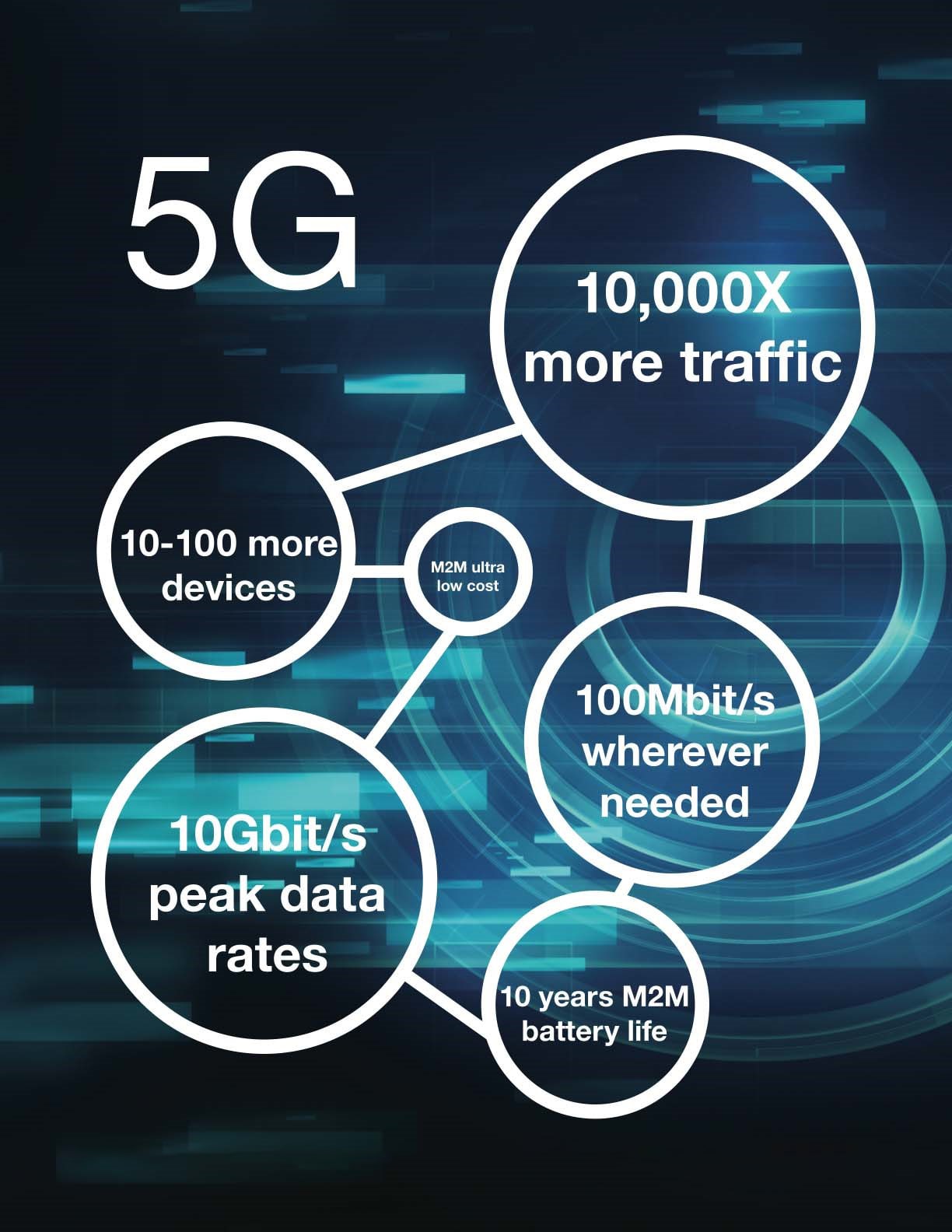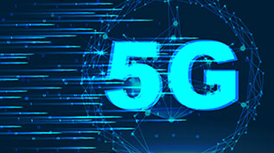A great percentage of American households are expected to have 4K- and 8K-capable televisions as it becomes more readily available and cost effective. Wired broadband can support 4K/8K video streaming in homes, but it can’t support data-thirsty apps on the go.
For that, much of the world is banking on Fifth Generation (5G) networks. In 5G cellular networks, the peak data rates are 10 gigabits per second (Gbps), which means downloading a 1.2 gigabyte (GB) ultra-high-definition (UHD) movie would require less than a second. Compared to its 3rd Generation Partnership Project (3GPP™) predecessors (2G and 3G/4G LTE), 5G’s expanded capacity is a big step forward in mobile connectivity.
Much like Moore’s law for computers, Nielson’s law of internet bandwidth predicts that bandwidth usage will increase by 50 percent every year. To help keep up with this exponential rise in bandwidth requirements, 5G wireless will need to deliver.
As device manufacturers and application developers prepare for 5G-capable products and services, it is important to assess the applicability of 5G in their respective use cases. The enormous promise of 5G as an ultra-low-latency broadband wireless technology must be gauged in relation to other technologies in the connectivity ecosystem. For example, several product categories exist for which 5G networks may not be a realistic choice. Price over performance is a crucial consideration when determining whether to adopt 5G over other connectivity options.
This article helps systems engineers evaluate the viability of 5G in the existing connectivity ecosystem.
What Distinguishes 5G Connectivity?
We have moved into an era dominated by cloud-based, connected applications. Every vertical industry is transitioning to service models in which the essential functions are dispensed from the cloud. This shift forces us to think differently about connectivity.
That’s where 5G fits in. The 5G standards provide a totally new framework for connectivity. In that sense, 5G paves a disruptive evolutionary path for existing connectivity concepts.
In addition to using spectrum in the existing Long-Term Evolution (LTE) range, 5G uses unlicensed spectrum in the millimeter wave (mmWave) bands. According to an article in IEEE Spectrum entitled “5G Bytes: Millimeter Waves Explained,” mmWaves, broadcast in the 30 to 300 gigahertz (GHz) frequency range, provide much higher bandwidths than the spectrums of former generations along with the added benefit of lower latencies. However, the mmWaves (1 to 10mm in length) cannot travel easily through buildings and other obstacles and are easily absorbed by rain, foliage, etc. One way to counter the mmWave propagation issues is with the use of 5G small cells. Compared to traditional cell sites, small cells are much smaller in size, more power efficient, and are becoming more affordable. Due to their inherent spectrum efficiency, small cells also increase wireless capacity to connect more “things” and data traffic.
A few other factors distinguish 5G networks in the digital landscape (Figure 1).

Figure 1: This snapshot diagram captures the 5G connectivity performance metrics. (Source: Mouser Electronics)
Ubiquitous Connectivity
The adoption of the Internet of Things (IoT) is already ramping up across all industry verticals. The IoT currently connects physical devices such as sensors, actuators, pumps, and cars. Billions of such devices will need network connectivity in the coming years to be able to communicate reliably with cloud-based services. Increased capacity from 5G small cells technology can support IoT devices and machine-to-machine (M2M) connectivity at a massive scale. Compared with 4G LTE, 5G offers 1,000 times more bandwidth per unit area, 10,000 times more traffic, and 100 times more connected devices per unit area.
Real-Time Performance
As the IoT hits industrial scale, connectivity must support applications such as remote control of machines, drones and robotics applications, time-sensitive industrial control loops, driverless car navigation, remote surgery, and more. For these mission-critical applications, high bit rates are not enough. To achieve real-time performance, latencies must also be very low. 5G standards extend broadband wireless services beyond mobile internet capacity to IoT applications that require ultra-reliable, fast, and mission-critical communications.
Energy Efficiencies
Whereas 4G is primarily a mobility solution, 5G (in addition to enhancing mobility) caters to fixed wireless and industrial IoT applications where devices operate in rugged environments, have a limited power supply, and run for decades. That’s why 5G is designed for up to a 90 percent reduction in power usage compared with 4G and up to 10 years of battery life for IoT devices.
Security and Reliability
Relatively speaking, communication over wireless connectivity is easier to intercept and more susceptible to man-in-the-middle attacks. In IoT use cases, low-power wireless connectivity is prone to bit rate errors and connection drops. The robust design of 5G is expected to offer 99.999 percent availability and include mutual authentication, local secure elements, Transport Layer Security (TLS) encryption, and over-the-air (OTA) firmware updates for 5G electronics. Much like virtual machines on virtualized hardware platforms, 5G network resources can be segmented into “network slices.” 5G network slicing enables service providers to build virtual, application-specific, end-to-end networks that offer additional security.
Mapping 5G Networks in the Connectivity Landscape
Excitement about the 5G rollout does not necessarily translate to deprecating (or sunsetting) existing technologies. In fact, ongoing innovations in time-sensitive networks (next-generation of Institute of Electrical and Electronics Engineers [IEEE] 802.1 Ethernet); low-power, wide-area networks (LPWANs); Wi-Fi; and long range (LoRa®) technologies are gaining traction as well.
Even after 5G standards are rolled out at mass scale, 5G technology will coexist with other technologies for the foreseeable future. In many scenarios, 5G technology will complement those technologies.
Fiber Optics and Fixed Broadband
The study “Communications Infrastructure Upgrade: The Need for Deep Fiber,” published in 2017 by Deloitte, shows that only 11 percent of internet traffic is carried over wireless connections, while 90 percent of the traffic traverses wired networks. Fiber optic networks offer high throughput and bandwidth with low latencies over long distances. In terms of bandwidth and speed, 5G wireless and fiber optics are comparable technologies. However, as connectivity solutions, these technologies are less competing and more complementary. In fact, the quality and reliability of 5G networks would depend on fiber-based wireline networks for backhaul transport of traffic between the small cells.
In smart homes and offices, 5G small cell access points can enhance indoor-coverage fiber and coaxial cable-based broadband internet solutions. The speed and flexibility of 5G wireless may replace legacy wireline networks in industrial and city infrastructures. In data center infrastructures and cloud computing servers, however, where the robustness and maturity of wireline technologies are critical, fiber optic and fixed Ethernet technologies will continue to dominate.
LPWANs
The desired capabilities of LPWAN technologies for IoT applications are:
- Device chipsets with low-processing and transmission power as well as a battery life exceeding 10 years to support long-term usage.
- Extended coverage (more than 10km suburban; more than 5km urban) with good penetration in buildings and basements.
- Device abilities to send small bursts of data intermittently, so the supported data rates are low (0.3 bits per second [bps] to 50 kilobits per second [Kbps]—typically, approximately 10 kilobytes per day [KBpd]).
- Secure data transmissions with low total costs of ownership.
LPWAN technologies are already prevalent in IoT edge deployments, where many low-cost IoT devices (such as sensors and meters) are spread over extended areas in operational environments. LPWAN adoption is expected to grow across global IoT markets over the coming years, even when 5G wireless is ready for commercial use. LPWAN technologies cater to use cases where 5G’s high data rates and low latencies are less compelling.
These generic requirements have been implemented in several LPWAN technologies. Here’s a quick roundup of common LPWAN technologies in the context of 5G connectivity:
Narrowband-IoT
Narrowband (NB)-IoT transmissions are designed using a more limited bandwidth, and hence are more energy efficient. NB-IoT user devices are designed for ultra-low complexity and cost less. NB-IoT has a significant spectrum efficiency. It can connect up to 50,000 devices per cell. NB-IoT can penetrate buildings and underground areas (offering 20dB or more coverage indoors) and are suitable for smart city applications with static assets.
Sigfox®
Sigfox is a proprietary technology that has already penetrated European markets and is supported by many electronics vendors. Sigfox uses a slow modulation rate for extended coverage. It is suitable for applications such as smart parking sensors, smart garbage cans, and utility meters, where the low-cost devices need to upload small, infrequent bursts of data to IoT gateways.
LTE for Machines
LTE for Machines (LTE-M) is a relatively recent innovation, and its power efficiency is still under evaluation. It can piggyback over existing 4G-LTE connectivity (and can evolve to be 5G compatible) to support roaming for mobile IoT assets like vehicles and drones. LTE-M electronics are among the most expensive options because they can offer data rates higher than other LPWAN options. Data-rich applications in the IoT edge can benefit from LTE-M.
LoRa
LoRa is a long range, low power, low data rate connectivity standard from the Lora Alliance™. LoRa is designed to enable large network operators to offer subscription-based LPWAN services. LoRa uses the unlicensed spectrum (sub-GHz radio frequency; e.g., 915MHz in North America) but relies on an additional layer of security because LoRa devices do not use subscriber identification modules (SIMs) or machine identification modules (MIMs) for device authentications or encryptions.
5G networks and LPWAN can be expected to complement each other in various end-to-end IoT deployments. For example, in the case of a remote surgery, the time-sensitive nature of communication requires real-time data transmissions. Scenarios like this are where low-latency 5G cellular networks fit. However, a remote surgery also involves sensor networks at the edge such as on the hospital premises to collect and process critical information locally. For these sensor networks at the edge, LPWAN connectivity is a more viable option.
Personal Area Network (PAN) and Local Area Network (LAN)
For local connectivity in homes and enterprises, Wi-Fi® and Bluetooth® technologies (based on IEEE 802.11 standards) and Bluetooth Low Energy are common options. 802.15.4-based technologies (including Zigbee®, ISA100.11a, 6LoWPAN, WirelessHART®, and Z-Wave®) support enterprise IoT applications such as asset and resource tracking.
Just like cable and fiber optic broadband solutions, 5G fixed broadband and cellular networks should complement Wi-Fi and Bluetooth. 3GPP’s Release 16 will include the 5G New Radio (NR)–Unlicensed standard, which supports existing 5 and 6GHz (“greenfield”) unlicensed frequency bands. One of the promising use cases of the 5G unlicensed spectrum will be “Wi-Fi-like” private networks in enterprises, large stadiums, and malls.
Satellite
In the connectivity ecosystem, while satellite technologies offer high bandwidth and reliability, they are expensive. As such, satellite serves only niche use cases. Onboard connectivity in aircraft, on freights, and on fleets using Global Positioning System (GPS) tracking across oceans, remote locations, underserved areas, and disaster zones, where mobile networks can fail, are some of the scenarios in which satellites are useful.
Satellite connectivity can augment 5G wireless to offer ubiquitous connectivity, by extending the coverage of 5G networks in areas where cellular connectivity is not feasible because of economic and other locational constraints.
Cellular: 4G-LTE
4G-LTE started rolling out in 2009, and in pre-5G days, it is the most advanced cellular technology available, with a peak rate of up to 1Gbps and latencies of 30 to 70 milliseconds (ms). With its 10Gbps data rates and less than a 1ms latency, 5G wireless is poised to evolve cellular networks into super-fast, responsive, power-efficient sources of connectivity.
Deployment of 4G networks is still in progress around the globe. It will take some time before 5G networks reach ubiquity and for 5G chipsets and devices to reach the market on a commercial scale. Use cases that do not require an ultra-high throughput and ultra-low latencies can continue to use 4G even after 5G has been rolled out. The 5G NR standard is designed to overlap and coexist with the 4G core network. So, at least from a technical design standpoint, compatibility has been built into 4G and 5G wireless-based cellular services.










